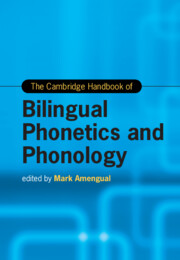Book contents
- The Cambridge Handbook of Bilingual Phonetics and Phonology
- Cambridge Handbooks in Language and Linguistics
- The Cambridge Handbook of Bilingual Phonetics and Phonology
- Copyright page
- Dedication
- Contents
- Figures
- Tables
- Contributors
- Acknowledgments
- Introduction Bilingual Phonetics and Phonology
- Part I Approaches to Bilingual Phonetics and Phonology
- Part II Theoretical Models of Bilingual Phonetics and Phonology
- 7 The Perceptual Assimilation Model: Early Bilingual Adults and Developmental Foundations
- 8 The Second Language Linguistic Perception Model
- 9 The Automatic Selective Perception Model
- 10 The Ontogeny Phylogeny Model
- 11 Bilingual Speech and Exemplar Theory
- Part III The Phonetics and Phonology of the Bilingual Child
- Part IV The Phonetics and Phonology of the Bilingual Adult
- Part V The Diversity of Bilingual Speakers
- Part VI Variables and Outcomes of Bilingual Speech
- Index
- References
10 - The Ontogeny Phylogeny Model
from Part II - Theoretical Models of Bilingual Phonetics and Phonology
Published online by Cambridge University Press: 14 November 2024
- The Cambridge Handbook of Bilingual Phonetics and Phonology
- Cambridge Handbooks in Language and Linguistics
- The Cambridge Handbook of Bilingual Phonetics and Phonology
- Copyright page
- Dedication
- Contents
- Figures
- Tables
- Contributors
- Acknowledgments
- Introduction Bilingual Phonetics and Phonology
- Part I Approaches to Bilingual Phonetics and Phonology
- Part II Theoretical Models of Bilingual Phonetics and Phonology
- 7 The Perceptual Assimilation Model: Early Bilingual Adults and Developmental Foundations
- 8 The Second Language Linguistic Perception Model
- 9 The Automatic Selective Perception Model
- 10 The Ontogeny Phylogeny Model
- 11 Bilingual Speech and Exemplar Theory
- Part III The Phonetics and Phonology of the Bilingual Child
- Part IV The Phonetics and Phonology of the Bilingual Adult
- Part V The Diversity of Bilingual Speakers
- Part VI Variables and Outcomes of Bilingual Speech
- Index
- References
Summary
This chapter discusses the Ontogeny Phylogeny Model (OPM), which focuses on the formation and development of second language phonological systems. It proposes an interrelationship between L2 native-like productions, L1 transfer, and universal factors. The model argues that chronologically, and as style becomes increasingly formal, L2 native-like processes increase, L1 transfer processes decrease, and universal processes increase and then decrease. It further claims that the roles of universals and L1 transfer are mediated by markedness and similarity, both of which slow L2 acquisition. Specifically, in similar phenomena L1 transfer processes persist, while in marked phenomena universal processes persist. The OPM also argues that these same principles obtain for learners acquiring more than one L2, monolingual and bilingual acquisition, and L1 attrition. In addition to the chronological stages and variation of the individual learner, the model claims that these relationships hold true for language variation and change, including pidgins and creoles.
Keywords
- Type
- Chapter
- Information
- The Cambridge Handbook of Bilingual Phonetics and Phonology , pp. 217 - 240Publisher: Cambridge University PressPrint publication year: 2024
References
- 1
- Cited by

